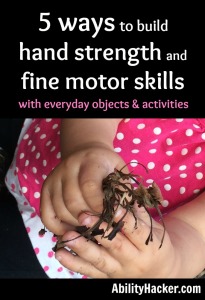 When my daughter passed the 6 month mark, I noticed that she kept her left hand in a fist most of the time. All the reading I did told me we should be concerned, so my insides kept knotting up as I obsessively watched her to determine whether her actions were typical or atypical. A few weeks later, my fears were confirmed. Her left hand was not developing normally. I marched out of the pediatrician’s office with an Occupational Therapy referral, and my preoccupation with getting her to use her left hand began.
When my daughter passed the 6 month mark, I noticed that she kept her left hand in a fist most of the time. All the reading I did told me we should be concerned, so my insides kept knotting up as I obsessively watched her to determine whether her actions were typical or atypical. A few weeks later, my fears were confirmed. Her left hand was not developing normally. I marched out of the pediatrician’s office with an Occupational Therapy referral, and my preoccupation with getting her to use her left hand began.
At first we tried simple things. During meals and playtime, we would purposely occupy her right hand by giving her a small object to hold, with the goal of having her reach for objects with her left. It seemed to take a significant effort and concentration for her to do something as simple as stretch out her fingers, so we also added an overnight splint to let her hand practice being open.
No one can explain why she has trouble with her left hand, nor can they explain why her entire left side is weaker than her right. All the doctors are able to tell us is that whether we have a reason or not, the treatment is the same: therapy and practice. Basically, push her to use it as much as possible so that she can teach her brain to make the connections now while she is young and the brain is more pliable.
We have tried a LOT of different things over the past three years. Some things worked, but others… not so much. I learned early on that nagging was NOT a successful strategy. Finding ways to make using her left hand fun worked significantly better. Things we found DID work:
- Getting creative with everyday objects & activities
- Buying & playing with toys which require two hands
- Making up silly games
- “Flipping” how we ask her to do things
- Constraint therapy
- Decorating Kinesio tape
This post will be the first in a series about encouraging kids to use both hands together (“bilateral coordination” if we want to use fancy OT terms  ). I’m going to tackle #1 on the above list first.
). I’m going to tackle #1 on the above list first.
Getting Creative with Everyday Objects and Activities
1. Two plastic cups and some water: Before I had kids, I didn’t realize how fascinating it can be to pour water from one cup into another and vice versa. This simple activity is one of my daughter’s favorites. Her left hand isn’t strong enough to pick up a cup full of water, but it CAN hold the receiving cup in place, or be the helper hand when a cup is particularly heavy (pouring out water using both hands to hold the cup).
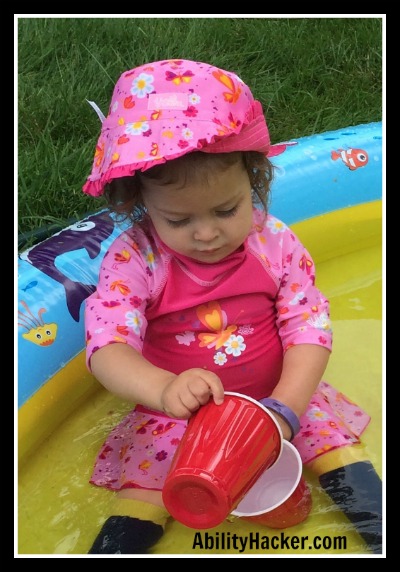
2. Plastic eggs aren’t just for Easter: You can open them. You can close them. You can hide treats and toys inside of them. Endless fun that cannot be enjoyed without both hands working together! I’ve considered hosting a tea party where all snacks are encased in plastic eggs which have to be opened in order to be enjoyed. I haven’t gone down this path yet, but I think it could be fun. 
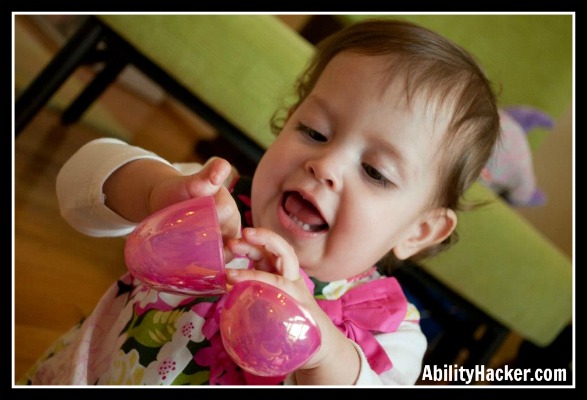
3. Writing or coloring on curved objects: Speaking of plastic eggs, coloring on them with a permanent marker is also a fantastic way to engage both hands together because one hand must hold the object while the other colors. Any curved object would work – styrofoam balls, ping pong balls, smooth stones, etc. You could also use paint rather than markers.
4. Gardening and digging in the dirt: One of my favorite summer activities is growing a small family garden. Last year, Lily was finally old enough to help, and the entire gardening process had a ton of opportunity for using both hands together – tearing open seed packages, dunking the plants in water before planting (holding plant with both hands), digging holes, refilling holes, and picking vegetables (holding the stem with one hand and pulling with the other). It was exciting to see her reaction to the plants growing over time, and as a bonus we got to eat some yummy veggies! Maybe this year she’ll actually eat something from the garden… (ah, my non-veggie eating girl).
5. Functional activities like getting a drink of water out of the cooler: When Lily started using her walker independently, she also began asking to stop at her school’s water cooler for a drink before heading home. At first, I filled the cup for her. However, one day she showed some interest in filling the cup herself, and it dawned on me that getting her own water is a great functional way to use both hands together.
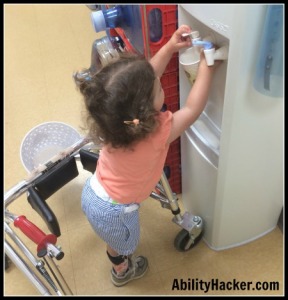
I think of this water cooler example as just one idea on a potentially long list of ways to encourage two hand usage with everyday functional activities. Opportunities surround us everywhere, and can be found by simply paying attention and looking for them. There are lots of two handed activities at meal times (cutting food, holding a cup or bowl while stirring, etc.), while getting dressed (helping take off and put on clothes), and while cleaning up toys (picking up heavy or large toys with two hands).
It often takes longer to let Lily help with these tasks using lefty and righty together, but I like to give her that gift of time whenever possible. FYI: It’s not always possible to give her the time. Life simply gets in the way sometimes, so we do the best we can.
What everyday activities do you find work well at encouraging your child to use both hands together?
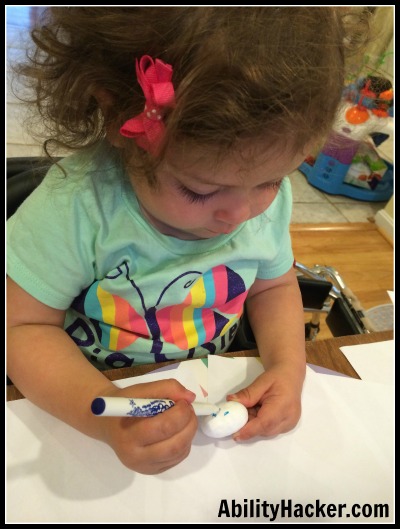
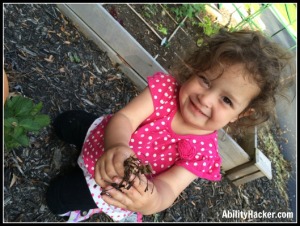
Just shared this post on Facebook and Pinterest. These are excellent suggestions and very helpful since you have tried all of them with your daughter. I too am always happily surprised at how much pouring water entertains children. Add in some food coloring and clear cups and it is a whole new activity!
If you need a few more ideas for hand strengthening you can read this blogpost http://yourtherapysource.com/blog1/2015/01/13/10-activities-to-work-on-hand-strengthening/
By the way, as a pediatric physical therapist and a mother, I love your blog! Super helpful to read a parent’s first hand account of what works for you and your daughter.
Thank you for the link – I will check it out! And thank you.
These are clear and practical ideas that can be worked into everyday activities. Great ideas.
Another bilateral activity is to shampoo her hair and reaching up with both hands.
You could try other bath time games that involve one or both hands…
Pulling apart pop beads.
Putting Shapes into the appropriate shaped “hole”
Great ideas!